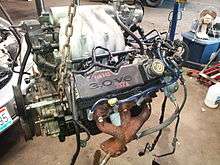Ford Vulcan engine
| Vulcan V6 | |
|---|---|
|
| |
| Overview | |
| Manufacturer | Ford Motor Company |
| Production | 1986-2008 |
| Combustion chamber | |
| Configuration | 60° V6 |
| Displacement | 2,986 cc (182.2 cu in) |
| Cylinder bore | 89.0 mm (3.50 in) |
| Piston stroke | 80.0 mm (3.15 in) |
| Cylinder block alloy | Cast iron |
| Cylinder head alloy | Cast iron |
| Valvetrain | OHV |
| Combustion | |
| Fuel system | Fuel injection |
| Fuel type | |
| Oil system | Wet sump |
| Cooling system | Water-cooled |
| Output | |
| Power output | 140–155 hp (104–116 kW) |
| Torque output | 160–186 lb·ft (217–252 N·m) |
| Chronology | |
| Predecessor | Cologne 2.9 |
| Successor | Duratec 30 |
The Ford Vulcan V6 is a 3.0 L (2,986 cc (182.2 cu in)), 60° V6 engine with a cast iron block and iron heads, used in some of Ford Motor Company's vehicles from model years 1986 through 2008. It was originally designed to be the optional engine in the Ford Taurus and Mercury Sable. In 1992, it became the standard engine for the Taurus, and was the only engine available in the 2006–2007 Taurus. It was also used in the Ford Probe, the Ford Tempo and Mercury Topaz from 1992–1994 (optional, but standard in the 1992 GLS, XR5, and LTS models),[1] the Ford Aerostar and Ford Windstar minivans, and the Ford Ranger and Mazda B3000 pickup trucks. It replaced the Cologne 2.9 engine (to which it is not related) as the base V6 in the Ranger.

The Vulcan was a clean-sheet design using the metric system. The engine block was cast by Cleveland Casting Plant from tooling built by Sherwood Metal Products, the intake came from Ford's Essex Casting, and the engine was assembled at Ford's Lima engine plant in Lima, Ohio.
The Vulcan is a straightforward pushrod design, with 2 valves per cylinder. Its bore is 89.0 mm (3.50 in) and its stroke is 80.0 mm (3.15 in). The engine was designed to use electronic fuel injection from the start (there was never a carburetor-equipped version), and was also sold in a "flexible fuel" configuration that could burn normal gasoline, E85 (a blend of 15% gasoline and 85% ethanol) or any mixture of these two fuels.
In 1991, the Vulcan was updated with reduced friction pistons, a strengthened block, roller camshaft and other changes that resulted in a power rating of 140 hp (100 kW) and a torque rating of 160 lb·ft (220 N·m). In 1996 further improvements were made; all Vulcans were now equipped with a Distributorless Ignition System (coil pack), with a new intake manifold, changes in engine management and cam timing; output was further increased to 145 hp (108 kW) and 170 lb·ft (230 N·m). In 2000, power output increased again, up 10 hp (7 kW) and 16 lb·ft (22 N·m). A plastic upper intake was added in 2001.
It is likely that Ford chose this name in homage to Vulcan, the mythological Roman god of fire and iron-working, as the engine is a fully cast iron design.
The last production vehicle available with the Vulcan was the 2008 Ford Ranger.
Applications:
- 1986–1997 Ford Aerostar
- 1986–2007 Ford Taurus
- 1986–2005 Mercury Sable
- 1990–1992 Ford Probe
- 1991–2008 Ford Ranger
- 1992–1994 Ford Tempo
- 1992–1994 Mercury Topaz
- 1994–2007 Mazda B3000
- 1995–2000 Ford Windstar
References
- ↑ "3.0L Vulcan History & Specifications". Tempo - Topaz Car Club of North America. Retrieved 2009-11-29.
See also
| Wikimedia Commons has media related to Ford Vulcan engine. |
